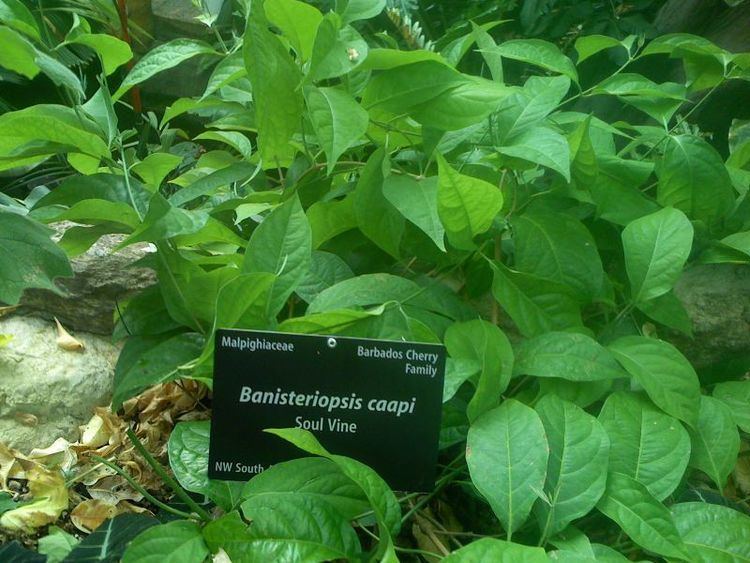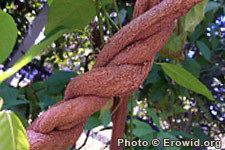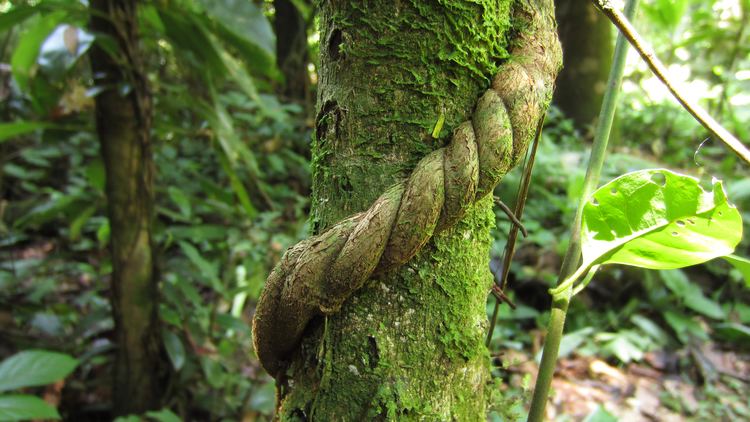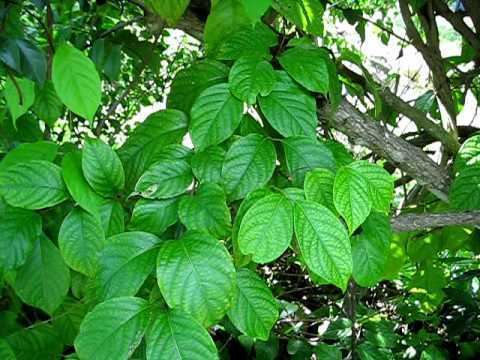Scientific name Banisteriopsis caapi Rank Species | ||
 | ||
Similar Diplopterys cabrerana, Psychotria viridis, Psychotria | ||
Banisteriopsis caapi aka ayahuasca plant vine what is it
Banisteriopsis caapi, also known as ayahuasca, caapi or yagé, is a South American liana of the family Malpighiaceae. It is used to prepare ayahuasca, a decoction with a long history of entheogenic uses as a medicine and "plant teacher" among the indigenous peoples of the Amazon Rainforest. It contains harmine, harmaline, and tetrahydroharmine, all of which are both beta-carboline harmala alkaloids and MAOIs. The MAOIs in B. caapi allow the primary psychoactive compound, DMT (which is introduced from the other primary ingredient in ayahausca, the Psychotria viridis plant), to be orally active. The stems contain 0.11-0.83% beta-carbolines, with harmine and tetrahydroharmine as the major components. Alkaloids are present in all parts of the plant.
Contents
- Banisteriopsis caapi aka ayahuasca plant vine what is it
- Banisteriopsis caapi harvesting preparing and ayahuasca cooking part 1 2
- Legality
- Patent issues
- Alkaloids
- References

According to The CRC World Dictionary of Plant Names by Umberto Quattrocchi, the naming of B. caapi was actually dedicated to John Banister, a 17th-century English clergyman and naturalist. An earlier name for the genus Banisteriopsis was Banisteria, and the plant is sometimes referred to as Banisteria caapi in everyday usage.

The name ayahuasca means "vine of the soul" in Quechuan, and the shamans of the indigenous western Amazonian tribes use the plant in religious and healing ceremonies. In addition to its hypnotic effect, caapi is used for its healing properties as a purgative, effectively cleansing the body of parasites and helping the digestive tract.

Banisteriopsis caapi harvesting preparing and ayahuasca cooking part 1 2
Legality

In the United States, caapi is not specifically regulated. A recent court case involving caapi-containing ayahuasca (which also contains other plants containing the controlled substance DMT, introduced from the Psychotria viridis plant), Gonzales v. O Centro Espirita Beneficente Uniao do Vegetal, was found in favor of the União do Vegetal, a Brazilian religious sect using the tea in their ceremonies and having around 130 members in the United States.

In Australia, the harmala alkaloids are scheduled substances, including harmine and harmaline, but the living vine, or other source plants are not in most states. On the State of Queensland as of March 2008 this distinction is now uncertain. In all states the dried herb may or may not be considered a scheduled substance, dependent on court rulings.

In Canada, harmala is listed under the Controlled Drugs and Substances Act as a schedule III substance. The vine and the ayahuasca brew are legal ambiguities, since nowhere in the Controlled Drugs and Substances Act is it stated that natural material containing a scheduled substance is illegal, a position supported by the United Nations International Narcotics Control Board.
Caapi, as well as a range of harmala alkaloids, were recently scheduled in France, following a court victory by the Santo Daime religious sect allowing use of the tea due to it not being a chemical extraction and the fact that the plants used were not scheduled. Religious exceptions to narcotics laws are not allowed under French law, effectively making any use or possession of the tea illegal.
Patent issues
The caapi vine itself was the subject of a dispute between U.S. entrepreneur Loren Miller and the Coordinating Body of Indigenous Organizations of the Amazon Basin (COICA). In 1986, Miller obtained a U.S. patent on a variety of B. caapi. COICA argued the patent was invalid because Miller's variety had been previously described in the University of Michigan Herbarium, and was therefore neither new nor distinct. The patent was overturned in 1999; however, in 2001, the United States Patent Office reinstated the patent because the law at the time the patent was granted did not allow a third party such as COICA standing to object. The Miller patent expired in 2003. B. caapi is now being cultivated commercially in Hawaii.
